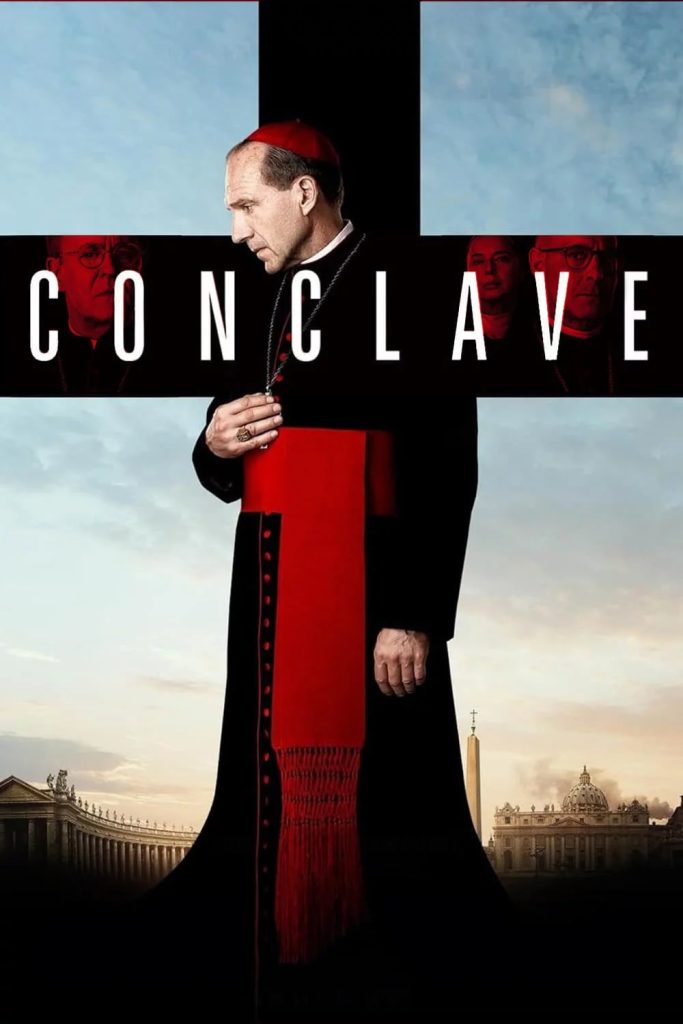
I’ll be honest—when I first saw the trailer for Conclave, it did not seem like my cup of tea. Knowing nothing except that it follows the classified process of electing a new pope, I was expecting a repetitive and preachy commentary on theology. But after devouring director Edward Berger’s brutal yet beautiful 2022 adaptation of All Quiet on the Western Front, I decided to give his newest thriller a shot. What I wasn’t expecting among the shots of cold marble chambers and endless scarlet cloth, was a layered and riveting exploration of the Vatican’s underbelly.
Based on Robert Harris’s novel of the same name, Conclave opens with Cardinal Lawrence (Ralph Fiennes) hurrying through dark streets with clenched hands , eventually entering a solemn, whisper-filled room where the pope had just died. From there, Lawrence, as the dean of the College of Cardinals, must oversee the selection process of the next pope—which, as the audience comes to see, is no holy affair. Although Lawrence is facing a spiritual crisis himself, he herds dozens of identically-clad cardinals through the conclave—a word stemming from Latin that literally translates to “room that can be locked up.” Until the words “Habemus Papam” (Latin for “We have a pope”) are announced, it’s a ruthless competition for the sequestered cardinals, especially for the lead papal candidates stealthily trying to claw their way to the top of the Vatican.
On its face, the film seems to solely focus on Roman Catholicism, yet the commentary is much more broad. In fact, the group of smooth and backstabbing hopefuls seems to mirror today’s harried political climate. For instance, while one liberal-leaning cardinal (Stanley Tucci) has an eye on progress, the wolfish Cardinal Tedesco (Sergio Castellitto), who pledges to use his papal power to revert to the traditional ways of the church, condemns any modern views in the process. While the film appears to situate female characters (primarily nuns) as retreating into the background to perform as servants and maids to the cardinals—inspecting dinnerware for perfection, cooking all the meals for the scores of cardinals—they play a bigger part. Isabella Rossellini, for instance, plays the thorny Sister Agnes, who is more observant than expected of her. When placed in the context of an institution synonymous with tradition, the intertwining of these familiar character tropes conveys the inevitable influence of a changing society.
What’s interesting about this film is its clever use of contradictions. It is intense, yet there are also tongue-in-cheek moments that expose the Catholic Church’s ironies and shortcomings. At some points, the audience even laughed out loud at the image of Tedesco—an embodiment of the Church’s archaic values—smoking a vape. While the film mainly takes place in one building, lending to the sense of isolation, the outside world begins encroaching as the conclave proceeds, exploding through the fresco-covered ceiling (literally).
I was hoping that this film would have the visceral cinematography of All Quiet on the Western Front (which won the Oscar for best cinematography in 2023), and I was notdisappointed. As the plot moves forward, emotional close-ups and awe-inspiring wide shotsregularly intermingle, combining the grand scale of Renaissance art with more modernsymmetrical techniques. For instance, a single cardinal dressed in bright red robes walksdown a clinical, fluorescent-lit papal apartment corridor, demonstrating the clash of the traditional institution with modernity. At one point, a bird’s eye view of cardinals walkingwith white umbrellas fills the screen, looking all the same on the surface but illustratingtheir true differences behind the locked conclave doors. Close-ups are used to showmoments of intense vulnerability. Ralph Fiennes’s stoic face encompassing the middle of theframe, renders his sorrow wholly palpable despite his attempts to suppress it. At one point, Cardinal Lawrence, seated with the other cardinals in the Sistine Chapel, stares at Michelangelo’s rendition of a hunched man being dragged to hell, mimicking Lawrence being dragged down by his own crisis of faith (or more specifically the Church institution)—a burden he only reveals in private.
While Conclave isn’t a heart-pounding thriller, its drama-filled twists have a surprisingly modern take on current events that is approachable for all audiences. Even if you’re not into this particular subject matter, the striking visuals, tense score, and emotive performances make it worth the watch.
